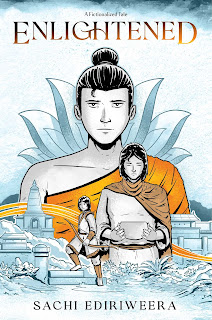Tentacles at My Throat by Zerocalcare
You know how, when you’re a kid, there are rigid rules to life that just seem to be there: generated by the kids themselves, random, unquestionable and bedrock?
Zerocalcare’s graphic novels are set in a world – well, they’re memoirs, officially, so it’s the world inside his head, the real world as he sees it or the way he thinks it’s more entertaining to pretend he sees it – based on that logic. It’s a world full of internal voices – society, peer pressure, desires, the weight of kid opinion – demanding that the main character must do X or Y in this situation, and must never do P or Q, no matter what.
Most of us grow out of that kind of thinking, or at least build different obsessive-compulsive structures in our adulthood. But Michele Rech – the Italian cartoonist who works as Zerocalcare – is not most people.
Tentacles at My Throat was his second graphic novel, after The Armadillo Prophecy ; it was published in Italy in 2014 and this edition, translated into English by Carla Roncalli di Montorio, came out in 2022. I’ve also seen Forget My Name , which I think was his third book. They’re all that sort of thing: mining the mindset of an obsessive, inward-focused childhood and young adulthood, a life intensely examined.
Of course, Zerocalcare constructs each one of these books carefully and deliberately; this isn’t just a rush of “how I really feel.” One major clue to that construction is that the specific internal voices are very different in each book – the internal voice, the superego if you will, of Armadillo was, yes, an armadillo. But here basically the same role is played by “David the Gnome,” the main character of the TV show based on the ’80s illustrated books. And the internal voices are much less central this time – they pop up to stop Zero from doing things, but aren’t the everyday companion the armadillo was.
So this one is a more typical memoir, made more dramatic and serious – in the way that kids do, when telling stories about their own lives – but mostly realistic and grounded. (There is what I think is a burst of fiction at the end, to tie off one loose end that I suppose Zero never learned the real history of, but nothing like the dive into pure fantasy at the end of Forget.)
Tentacles is a three-part story, centered on his school. The main characters are a group of kids, most centrally Zero himself, his friend Slim – who I suspect may be a composite; he’s appeared in every book so far and has been central in all of them – and their friend Sarah. The three sections are of equal length, taking place when Zero is seven, sixteen, and twenty-seven. The first two center on sneaking out of the school to do something – both in that vaguely transgressive and somewhat ritualized way kids have: “prove you’re brave by sneaking under the fence you’re never supposed to cross, and doing this specific thing to prove you did it.” And the third section is the usual reason former students come back to their old school: someone has died.
Of course Zero obsessed about what happened for years afterwards; that’s what he does. The fact that he “betrayed” one of his friends at the age of seven – as always with Zero, his internal dialogue obsessively focuses on that, on how horrible and unreclaimable he is, how everyone would hate him forever if only they knew the truth, and on and on and on.
And, of course, it’s never as bad as he assumes. That’s the point of this spiraling: it can’t possibly be as bad as the person spiraling worries. I do wonder if the “Zerocalcare” of his stories is going to move forward into that realization at any point, or if they’ll stay stuck in that childhood/young adulthood nexus of fear, doubt, and shame. My understanding is that he’s shifted formats over the past few years – moved from telling these stories in graphic novel form into telling them in animated TV-show form, so he can run through them all again and do the same thing over – but, eventually, the character of Zero will have to move out of the conflicted, neurotic twenty-something life, right?
As always with Zerocalcare, I find it’s a bit too overwrought for me. I want to reach into the page, shake Zero, and tell him to just mellow out – nothing is as earth-shaking or as central as he’s sure every last bit of it is.
(Or maybe he’s right, because this is the world he constructed. As far as I can tell, his group of friends have already utterly ruined the lives of two of their schoolmates, and that’s played for laughs. Ha ha! Lifelong trauma because they happened to be there, and aren’t the heroes! It’s funny!)
I guess I’m saying that I appreciate the skill and craft and energy of Zerocalcare’s work, but I hope he’s massively exaggerating a lot of this stuff, because otherwise he and his buddies come across, frankly, as a bunch of horrible little monsters. More than most kids, even.
Reposted from The Antick Musings of G.B.H. Hornswoggler, Gent.





















